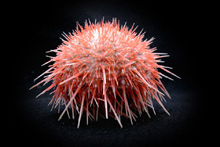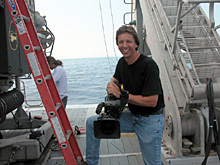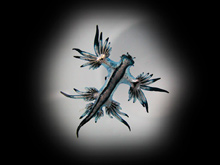
Sea urchins like this one were collected during several Johnson-Sea-Link II dives in the proposed marine protected area. Photo credit: Art Howard, NAPRO. Click image for larger view.
Filming Science at Sea
August 22, 2003
Liz Baird
North Carolina Museum of
Natural Sciences
Co-principal Investigator
Good photography takes people places where they don't normally get to go. Shots taken from space, or on top of distant mountain peaks, instill a sense of awe in the viewer. The Life on the Edge expedition is attempting to take people down in a submersible through high definition (HD) video technology. HD video is a totally digital technology that allows people to see detail that they have never seen before on film. The average television picture has 400,000 pixels; HD has 2.5 million. The image is also 50% wider.

Videographer Art Howard prepares to take a dive in the Johnson-Sea-Link II manned submersible. Photo credit: Liz Baird. Click image for larger view.
There are challenges associated with filming science at sea. Members of the science team have to make certain they bring everything needed for their research, such as laptops, collection containers and plenty of backup materials. Likewise, Art Howard, photographer aboard the R/V Seward Johnson, has to bring plenty of materials and equipment with him. The unpredictable weather and shooting conditions mean that Art has to cope with the glare, the saltwater and the combination of above-water and below-water shooting. There is shooting in the dark, during the brightest sunshine, during rough seas, and when the sea is as calm as a bathtub.
Filming on board presents a unique set of challenges. Sound is almost more important than the images in a production, because the sounds and music help viewers make an emotional connection to what they see. Aboard ship, the continuous hum of the engines is a constant background noise. Filming what comes up in the sub, or trying to catch people as they return from a dive, happens directly in front of the noisy engine room door. Of course the gentle sound of the ocean splashing off the bow is appreciated, but howling wind and crashing surf can drown out any dialogue.

The Johnson-Sea-Link II submersible in mid-deployment from the R/V Seward Johnson for an afternoon dive. Photo credit: Art Howard, NAPRO. Click image for larger view.
Visual images are not easy to come by either. Ship’s equipment is stored where it is most convenient, which, unfortunately, is usually in the best line of site for filming. To get a straight-on shot of the sub launch or recovery puts you directly underneath the line that secures the sub –- a forbidden area for safety reasons. Art also has to be mindful of what the images will look like when projected on the 22-ft screen at the North Carolina Museum of Natural Sciences. The constant up- and-down motion of a distant horizon might be tolerable on a small scale, but on a large scale it could make people seasick!
The bow of the Johnson-Sea-Link II is a large plexiglass sphere. Two people share the space with all of the computers, navigation equipment, video controls for the sub camera, and switches for using the manipulator arm. At 30 in long and 10 in wide, the camera fills Art’s lap entirely. There is no room between the front of the lens and the plexiglass of the sphere. Art says it is tough to maneuver, noting “It’s either pointing directly out the front, or straight up and down -- I can’t pan the camera from side to side without running into something.”
While on board the ship, Art tries to make himself “invisible.” He wants the scientific party and the ship’s crew to be comfortable enough with him and the camera so that they just do what they need to do. He does not want them to change their behaviors. He hopes the camera will be viewed as “just another piece of equipment.” Many of this year’s science team and ship’s crew participated in last year’s mission, so they are familiar with Art and his camera. They appreciate his consideration when filming, his excitement about the sea, and his willingness to put down the camera and help sort Sargassum when the catch is enormous.

This iridescent nudibranch looks like a creature from another planet, but was actually found attached to Sargassum. The clarity of the image reveals details of this one-inch organism that are almost impossible to see with the naked eye. Photo credit: Art Howard, NAPRO Click image for larger view.
People tend to shy away from math and science, and Art sees this film as a way to get people interested in science through the backdoor. He hopes that people will be surprised by the beauty of the silver and blue nudibranch, the intensity of the eye of a bigeye fish, or the spines of a lionfish. Art’s desire is that people will leave “wanting more." He says he hopes that when people who see the movie go to the coast of North Carolina, they will “realize it doesn’t stop at the breakers. That they will get out of the pool, put on a snorkel and go and see what's out there. I hope they will discover that all things are truly connected.”
Art wants the public to see the passion of the scientists on board ship. He tries to use HD to encourage others to make an emotional connection with “stuff they don’t necessarily understand.” In this case, he hopes the audience will fall in love with the research and walk away with a greater appreciation for our state’s coastal beauty.





















